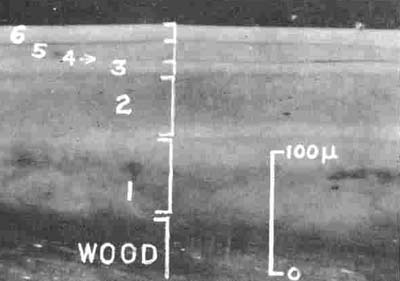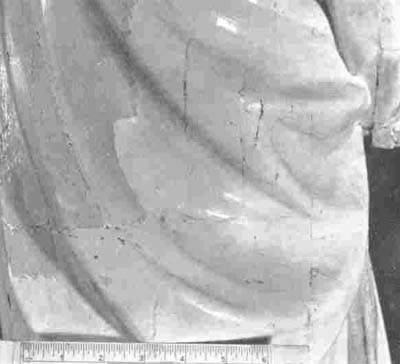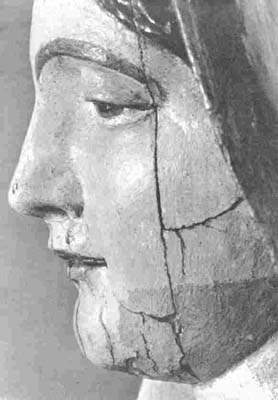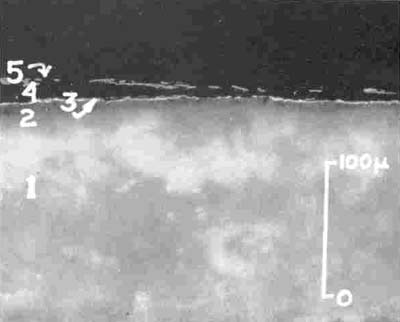
Bulletin 2 (I:2), December 1963
Home
Français
Introduction
History
Annual Index
Author &
Subject
Credits
Contact
![]()




![]()
From the Laboratory of the National
Gallery
by Nathan Stolow,
Chief Conservation and Scientific Research
Division
Pages
1 | 2
| 3 | 4
| 5
The Virgin and Child
Attributed To The
Labrosse Atelier
This work is a polychromed wood sculpture transferred to the
National Gallery of Canada from the Musée de Chambly. Again no
technical history was available from previous records. (13) The
carving was very generously coated with a glossy, white enamel paint
which obscured to a great extent the original surfaces of paint and
gilding. The work consists of a great number of glued pieces of
softwood (probably Eastern Canadian White Fine), and was
apparently not carved from one block. The overall appearance of the
sculpture before treatment is shown in Fig. 6. The overall height
(excluding base) is 63 inches, and the maximum circumference 70
inches. The periodic splitting and separating of the glued pieces
of the sculpture had necessitated restoration treatment in the past,
and judging from the fills and especially the application of the
white paint, such treatment had been most inexpertly carried out.
It was first necessary to locate the original polychromy underneath
and to survey the extent of its coverage on the wood. For this
purpose the technique of mounting and cross-sectioning of paint
particles was used. (14) While the layer structure varied with the
particular location from which the cross-section was taken, a
fairly consistent structure was found in the cloak and drapery of
the Virgin. This is illustrated in Fig. 7. Here there are six layers
of paint and other coatings: from the top downwards they are enamel
white, grey white paint, another thin grey layer visible only by
ultra-violet incident light fluorescence, (15) another grey layer of
paint, white lead layer (basic lead carbonate), chalk ground, and
finally the wooden surface. The white enamel paint covered most of
the carving, and in particular covered in a single coat the
inserted fills of wood of previous restorations. Areas not covered
by the enamel were the feet, face and hands of the Virgin, the
Child's head, and the areas of gilding. The flesh and hair colours
had been coated with a heavy layer of darkened varnish, and in the
Child the pinkish skin had been obscured by the white enamel paint.
Cleaning tests, in conjunction with cross-section analyses, showed
that the brownish varnish on the face and feet of the Virgin and on
the Child's head, could be removed with a mixture of shell sol, acetone, and cellosolve in the proportions of 3:1:1. There was,
however, some risk of damage by solvent action in the removal of the
varnish from the hair regions. The original brown hair was probably
resinous in composition. The white enamel over the pink of the
Child's body was removable by swelling with ethyl alcohol followed
by mechanical scraping. The removal of the major overpaint, i.e.,
the white enamel paint, required considerable study. It was found
that the most efficient means for its removal was to employ a very
selective and penetrative swelling agent which would act most
quickly in the penetration and swelling of the two top layers of
overpaint (e. g., layers 6 and 5 of the cross-section in Fig. 7),
such a solvent being dimethyl formamide. (16) By a pre-determined
method of application of this solvent, i.e., by adding the right
amount of solvent to a given area of overpaint, and by applying the
scalpel at the right time of softening or swelling, it was possible
to remove the two top layers before there was any appreciable
swelling action on the layers underneath. Any residual absorbed
dimethyl formamide would be permitted to evaporate away. The
appearance of the partly cleaned sculpture is shown in detail of
Fig. 8. The cleaned areas reveal the ancient polychromy with its
encrusted layer of dirt (probably layer 4 of Fig. 7).
On the basis of the condition and examinations made, treatment
commenced. This involved complete removal of overpaint, old fills,
embrittled glue in joints, the filling of losses where feasible,
reconstructing the lacunae (it was decided not to reconstruct the
Child's feet), inpainting, regilding, and applying fungicide to the
hollow interior of the carving. The following are brief notes
extracted from the treatment report: (17)
The varnish on the hair of the Virgin and that of the Child could
not be safely removed with solvent as had been judged during the
examination tests. It was found that the hair colour was very thinly
applied over a whitish ground, and was very readily removed by
solvent action. Since no aesthetic gain could result, the cleaning
of the hair was abandoned. The removal of the white enamel proceeded
quite smoothly using the dime thyl formamide. Its removal revealed
considerable damages in the numerous joints, restorations, embrittled
adhesive, and a general condition which could not be determined
except by cleaning. The losses were compensated for by filling and
levelling off with the surrounding areas of polychromy, using for
this purpose calcium carbonate mixed with parchment size adhesive.
The inpainting of these filled areas was carried out by means of
pigments ground in Rhoplex emulsion. (18) This contributed to the
overall matt appearance of the cleaned sculpture.
The removal of the white enamel paint revealed worn and rubbed
gilding on the edges of the Virgin's robes, and also on the ball
held in the Child's hand. In some areas the gilding was shown to be
metallic or bronze leaf, apparently of more recent restoration
(see for example the cross-section of Fig. 10). The rubbed,
eroded, or overbronzed gilding was redone using gold leaf applied
over a preparatory layer of red armenian bole. Toning of the gilded
surface was achieved with a suspension of burnt umber in a solution
of polyvinyl acetate in toluene.
The base was detached, revealing the hollow interior of the
sculpture and confirmed the 'patch-work quilt' piecing-together of
the wood. After vacuuming, the interior was sprayed with a fungicide
consisting of 10% paradichlorobenzene in carbon tetrachloride. The
base was replaced with one of sounder construction and more
harmonious with the completely restored Virgin and Child (see Fig.
11).
Next Page | The Toilet of Venus
1 | 2 | 3
| 4 | 5
Annual Index | Author & Subject | Credits | Contact
This digital collection
was produced under contract to Canada's Digital Collections program,
Industry Canada.
"Digital
Collections Program, Copyright
© National Gallery of
Canada 2001"